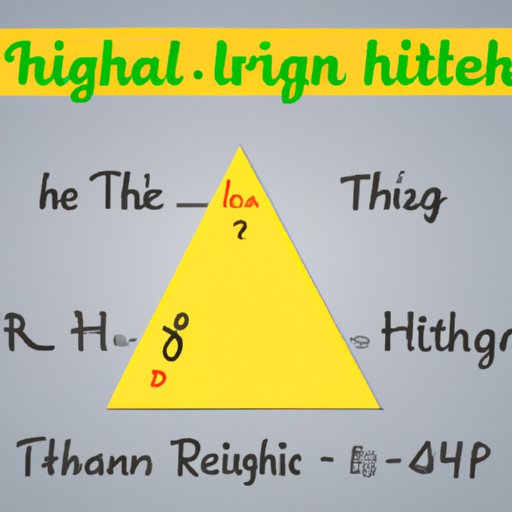
Introduction
Have you ever been in a situation where you need to measure the height of a triangle, but don’t know how to do it? Whether you’re a student learning geometry, an engineer designing a building, or an outdoor enthusiast estimating the height of a tree, knowing how to find the height of a triangle is an essential skill. In this article, we’ll provide you with a step-by-step guide on how to find the height of a triangle, explore real-world applications of the concept, show you visual aids to make it easier to understand, compare different methods, and introduce an interactive tool to help you practice.
Step-by-Step Guide
The formula to find the height of a triangle is:
height = (2 x triangle area) / base
where the base is the length of the side of the triangle that is perpendicular to the height, and the triangle area is calculated using the following formula:
triangle area = (base x height) / 2
1. Identify the base and the area of the triangle.
2. Substitute the identified values into the formula for triangle area.
3. Double the result to get the area of the triangle.
4. Divide the doubled area by the length of the base to get the height of the triangle.
For example, let’s say a triangle has a base of 6 cm and an area of 12cm². Firstly, we calculate the area of the triangle, using the above formula:
12 = (6 x height) / 2
12 = 3 x height
height = 4
Thus, the height of the triangle is 4 cm.
Real-World Applications
The height of a triangle is not only an essential concept in mathematics, but it also plays a vital role in various practical applications. The method of indirect measurement using the height of a triangle is commonly used in fields like architecture, engineering, and more.
For instance, let’s say you need to estimate the height of a building or a tree. By measuring the base and finding the height of the triangle formed between the object and its shadow, you can estimate the height quite accurately.
Visual Aids
To understand the formula better, diagrams and pictures can be very helpful. For example, drawing diagrams on paper or using online tools like GeoGebra can provide a graphical representation of the triangle’s dimensions, enabling you to apply the formula with ease.
Comparison with Other Methods
While finding the height of a triangle using the above formula is the most accurate way, there are other methods available, including:
1. Pythagorean theorem – Using the lengths of all sides of the triangle and the Pythagorean theorem to find the height.
2. Similar triangles – Using the concept of similar triangles and their corresponding sides to find the height.
Each method has its pros and cons, depending on the available information, and the accuracy required. It’s always best to pick the method that is most suitable for your situation.
Interactive Tool
If you’re finding it challenging to understand the concept of finding the height of a triangle, an interactive tool could be an excellent way to practice and improve your skills. Many online websites, such as Math Warehouse, offer interactive tools that allow you to input the triangle dimensions and obtain the height efficiently.
However, be aware that interactive tools come with limitations. They only provide answers based on the inputs provided, and they cannot help you in situations where you do not have complete information.
Conclusion
As you can see, finding the height of a triangle is a straightforward process, and it has many practical applications. By understanding the formula, using visual aids, and selecting the right method, you can quickly and accurately find the height of a triangle in various situations. Keep practicing and applying the concept, and you will see how useful it can be.




